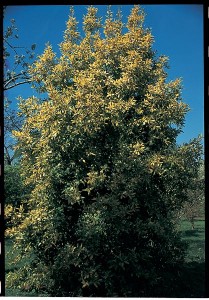Sick Bay Tree
 Question from Tony:
Question from Tony:
Thank you for your advice on the atlas cedar. I’ve replanted a nice specimen in a raised planter over soil that has been treated with gypsum for better drainage.
I hope to get your help with a new problem. For many years I’ve had a dwarf bay tree in a large pot, and it does very well. Within the last few weeks, the leaves have gone brown and feel somewhat dry. I first thought it was lack of water, but deep watering and fertilizer have not made a difference. There are new leaves coming out, and soon they get a rusty edge. Some have a black spot on them. I fear some kind of disease. Please advise.
Thank you for always being generous with your knowledge.
Answer from Pat:
Bay tree (Laurus nobilis) is subject to Phytophthora root rot http://www.google.com/imgres?imgurl=http://www.forestryimages., a disease of certain species of plants especially when grown in poorly drained soils. http://www.ipm.ucdavis.edu/PMG/r107100111.html
When a plant suffers from this disease it usually collapses and gets brown all over or on one side. Looking at your photo, I fear this may be the problem, because I note that part of the plant is brown all over. Additionally you remarked that there are some black spots. This is one characteristic of Phytophthora. Unfortunately there is no known cure for this disease. If this is the problem, willy-nilly the plant will die. Watering it more would only make it sicker and fertilizing was not the correct solution either. (More on that point in a moment). If the plant dies, bag it in a black plastic trash bag and tie up the bag. Then throw it out in the trash including the soil so your garden does not get infected. Be sure to disinfect any tools you may have used on this plant and also the pot with a solution of Chlorox and water so that the disease does not spread to other susceptible plants in your garden. Then go out and buy another bay tree and grow it in fresh soil with good drainage and pot it on gradually as it grows larger. Bays are big trees and they need root pruning annually once their roots have filled a large container. If you do not do this the plant will always die eventually, but by root pruning, you can keep a tree growing indefinitely in a container. I will try to make a video of this process on a camellia sometime if I can find a root-bound camellia in a pot. I must remember to ask my garden club if anyone has one.
The crisp brown tips and edges of older leaves shown in your photo are also classic signs of severe salt damage. I hope this is the problem since there is a cure for it. Salt burn usually results from a build-up of salts in the soil from too much fertilizer and not enough flushing out with clear water. In this case flushing with water would have been a good idea but fertilizing more was not. There is a rule of thumb that says “Never feed a sick plant.” Salt damage can also result from watering too lightly with hard water, such as softened tap water or simply water from the hose. Light watering means salts stay in the soil. That’s why we must always irrigate with adequate water so that water flows freely out the bottom of the pot. Then let the soil dry somewhat between waterings. Also, never use softened house water for irrigating house plants since it is full of salts. Purified water is okay and ordinary hose water is okay despite it’s being alkaline, but then plants need rain water in winter to set things right again.
It is a great idea to put some buckets outside and collect some of this good rain water that Mother Nature is pouring down on us from the sky right now. There is no salt in it. Fresh rainwater is great for flushing out the salts in pots of house plants and other salt-ridden potting soil.
Another problem that can lead to wet and salty soil is when the drainage hole in the bottom of the container is filled with roots thus preventing the water from escaping, so they stayed wet. Often a pot left standing on a patio makes a mat of roots beneath it. Make sure this does not happen by placing it on small pieces of broken pottery or on ceramic “pot feet” made especially for the purpose. Once roots have filled the soil, slide the plant out of the pot and prune the roots. If you can catch some rain water in a bucket, wash the roots thoroughly with rain water to wash out the salts. Then repot in a larger container with fresh soil, with a piece of broken pottery over the drainage hole so the plant has good drainage. Use humic acid mixed in the irrigation water, if you have it to encourage fresh roots to grow. Humic acid is the most effective of all transplanting fluids but it is not absolutely necessary.

